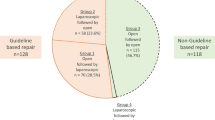Abstract
Purpose
There is paucity of data regarding patient selection criteria, anaesthetic preferences and outcomes of elective inguinal hernia repair in public and private sector in the UK. This study aimed to compare such outcomes.
Methods
Five hundred and fifty-five consecutive inguinal hernia repairs performed by one consultant surgeon in public and private sector were reviewed from a prospectively maintained database. The patient demographics, anaesthetic choice, day case rates and early and long-term morbidity were analysed.
Results
The median age of the study group was 59 years (range 16–96 years) with a male/female ratio of 21:1. A total of 436 (78 %) patients underwent surgery in the public sector and 119 (22 %) patients in the private sector. The patients undergoing surgery in the private sector were younger compared to public sector (55 vs. 60 years, p = 0.03). The number of patients with ASA grades III and IV was higher in public sector (28.6 %) compared to private sector (p = 0.0001). General anaesthesia was the preferred anaesthetic technique in the private sector (52 %) and local anaesthesia in the public sector (66 %) (p = 0.0002). The day case rates were higher than in the private sector compared to public sector (78 vs. 66.5 %, p = 0.01). No significant difference was noted in the incidence of post-operative complications, recurrence, groin pain and satisfaction rate between the two groups.
Conclusion
Patients undergoing surgery in the private sector are younger, healthier, prefer general anaesthesia and have higher day case rates compared to public sector. The short- and long-term outcomes are similar between public and private sectors.
Similar content being viewed by others
References
http://www.nice.org.uk/media/D7A/57/UptakeReportLapHerniaPublicationApril.pdf
Chard J, Kuczawski M, Black N, van der Meulen J, POiS Audit Steering Committee (2011) Outcomes of elective surgery undertaken in independent sector treatment centres and NHS providers in England: audit of patient outcomes in surgery. BMJ 2011(19):343
Kehlet H, Bay Nielsen M (2005) Anaesthetic practice for groin hernia repair—a nation-wide study in Denmark 1998–2003. Acta Anaesthesiol Scand 49:143–146
Kurzer M, Kark A, Hussain ST (2009) Day-case inguinal hernia repair in the elderly: a surgical priority. Hernia 13(2):131–136
Barbiere JM, Greenberg DC, Wright KA, Brown CH, Palmer C, Neal DE, Lyratzopoulos G (2012) The association of diagnosis in the private or NHS sector on prostate cancer stage and treatment. J Public Health (Oxf) 34(1):108–114
Finkelstein JB, Stamell EF, Zilbert NR, Ginsburg HB, Nadler EP (2010) Management and outcomes for children with pyloric stenosis stratified by hospital type. J Surg Res 158(1):6–9
Kehlet H, Bay-Nielsen M (2008) Local anaesthesia as a risk factor for recurrence after groin hernia repair. Hernia 12(5):507–509
Sanjay P, Harris D, Jones P, Woodward A (2006) Randomized controlled trial comparing prolene hernia system and lichtenstein method for inguinal hernia repair. ANZ J Surg 76(7):548–552
Alfieri S, Di Miceli D, Doglietto GB (2007) Prophylactic ilioinguinal neurectomy in open inguinal hernia repair. Ann Surg 245(4):663
Nilsson E, Haapaniemi S, Gruger G, Sandblom G (1998) Methods of repair and risk for reoperation in Swedish Hernia surgery from 1992 to 1996. Br J Surg 85:1689–1691
Simons MP, Aufenacker T, Bay-Nielsen M, Bouillot JL et al (2009) European Hernia Society guidelines on the treatment of inguinal hernia in adult patients. Hernia 13(4):343–403
Cheek CM, Black NA, Devlin HB, Kingsnorth AN, Taylor RS, Watkin DFL (1998) Groin hernia surgery: a systematic review. Ann R Coll Surg Engl 80(Suppl 1):S1–S80
Sanjay P, Woodward A (2007) Inguinal hernia repair: local or general anaesthesia? Ann R Coll Surg Engl 89(5):497–503
Kingsnorth AN, Bennett D, Cummings GC, Porter C (2002) Local anaesthesia in elective inguinal hernia repair. Eur J Surg 168:391–396
Memtsoudis SG, Besculides MC, Swamidoss CP (2006) Do race, gender, and source of payment impact on anesthetic technique for inguinal hernia repair? J Clin Anesth 18(5):328–333
National Centre for Social Research, British Social Attitudes Survey [computer file] (2005) Colchester, Essex: UK Data Archive [distributor], 2007. SN: 5618. doi:10.5255/UKDA-SN-5618-1
Ismail W, Zbar AP, El Gazzar O, Beddow E (1999) Anaesthesia for groin hernia repair—patient choice. Ambulatory Surgery 7:139–143
Author information
Authors and Affiliations
Corresponding author
Rights and permissions
About this article
Cite this article
Sanjay, P., Marioud, A. & Woodward, A. Anaesthetic preference and outcomes for elective inguinal hernia repair: a comparative analysis of public and private hospitals. Hernia 17, 745–748 (2013). https://doi.org/10.1007/s10029-012-1011-5
Received:
Accepted:
Published:
Issue Date:
DOI: https://doi.org/10.1007/s10029-012-1011-5




